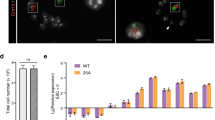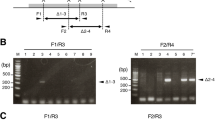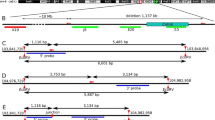Abstract
CHROMOSOMAL rearrangements are the major cause of inherited human disease and fetal loss1. Translations2 and loss of heterozygosity3 are important genetic changes causally involved in neoplasia. Chromosomal variants, such as deficiencies, are commonly exploited in genetic screens in organisms such as Drosophila because a small portion of the genome is functionally hemizygous4. In the mouse, deficiencies are not generally available, thus genetic screens for recessive mutations are cumbersome5. We report here that defined deficiencies, inversions and duplications extending to 3-4 cM can be constructed in embryonic stem cells. This was achieved by consecutive targeting of loxP recombination substrates to the end points of a genetic interval followed by Cre-induced recombination. This reconstructs a positive selectable marker which facilitates direct selection of clones with a chromosome structure specific to the relative orientation of the loxP sites. Duplication and deletion alleles have been transmitted into the mouse germ line. The availability of mice with defined regions of segmental haploidy will allow their use in genetic screens and enable accurate models of human 'chromosomal' diseases to be generated.
This is a preview of subscription content, access via your institution
Access options
Subscribe to this journal
Receive 51 print issues and online access
$199.00 per year
only $3.90 per issue
Buy this article
- Purchase on Springer Link
- Instant access to full article PDF
Prices may be subject to local taxes which are calculated during checkout
Similar content being viewed by others
References
Epstein, C. J. The Consequences of Chromosome Imbalance: Principles, Mechanism and Models (Cambridge Univ. Press, 1986).
Rabbitts, T. H. Nature 372, 143–149 (1994).
Lasko, D., Cavenee, W. & Nordenskjold, M. A. Rev. Genet. 25, 281–314 (1991).
Muller, H. J. Science 66, 84–87 (1927).
Vitaterna, M. H. et al. Science 264, 719–725 (1994).
Holdener-Kenny, B., Sharan, S. K. & Magnuson, T. BioEssays 14, 831–839 (1992).
Rinchik, E. M. & Russell, L. B. in Genome Analysis Volume II, Genetic and Physical Mapping (eds Davies, K. E. & Tilghman, S. M.) 121–158 (Cold Spring Harbor Laboratory Press, New York. 1990).
Zhang, H., Hasty, P. & Bradley, A. Molec. cell. Biol. 14, 2404–2410 (1994).
Golic, K. G. & Lindquist, S. Cell 59, 499–509 (1989).
Golic, K. G. Science 252, 958–961 (1991).
Medberry, S. L., Dale, E., Qin, M. & Ow, D. W. Nucleic Acids Res. 23, 485–490 (1995).
Qin, M., Bayley, C., Stockton, T. & Ow, D. W. Proc. natn. Acad. Sci. U.S.A. 91, 1706–1710 (1994).
Smith, A. J. H. et al. Nature Genet. 9, 376–385 (1995).
Sauer, B. Meth. Enzym. 225, 890–900 (1993).
Sternberg, N. & Hamilton, D. J. molec. Biol. 150, 467–486 (1981).
Sauer, B. & Henderson, N. Nucleic Acids Res. 17, 147–161 (1989).
Gu, H., Marth, J. D., Orban, P. C., Mossman, H. & Rajewsky, K. Science 265, 103–106 (1994).
Matzuk, M. M., Finegold, M. J., Su, J.-G. J., Hseuh, A. J. W. & Bradley, A. Nature 360, 313–319 (1992).
Rubock, M. J. et al. Proc. natn. Acad. Sci. U.S.A. 87, 4751–4755 (1990).
Fuller, P. J., Stone, D. L. & Brand, S. J. Molec. Endocrinol. 1, 306–311 (1987).
The, V. L. et al. Molec. Endocrinol. 3, 1301–1309 (1989).
Cropp, C. S. et al. Cancer Res. 54, 2548–2551 (1994).
Miki, Y. et al. Science 266, 66–71 (1994).
Saito, H. et al. Cancer Res. 53, 3382–3385 (1993).
Mori, T. et al. Cancer Res. 54, 1638–1640 (1994).
Gao, X. et al. Cancer Res. 55, 1002–1005 (1995).
Neuhausen, S. L. & Marshall, C. J. Cancer Res. 54, 6069–6072 (1994).
Roelink, H., Wagenaar, E., Lopes-da-Silva, S. & Nusse, R. Proc. natn. Acad. Sci. U.S.A. 87, 4519–4523 (1990).
Soriano, P., Montgomery, C., Geske, R. & Bradley, A. Cell 64, 693–702 (1991).
Ramirez-Solis, R. et al. Analyt. Biochem. 201, 331–335 (1992).
Author information
Authors and Affiliations
Rights and permissions
About this article
Cite this article
Ramirez-Solis, R., Liu, P. & Bradley, A. Chromosome engineering in mice. Nature 378, 720–724 (1995). https://doi.org/10.1038/378720a0
Received:
Accepted:
Issue Date:
DOI: https://doi.org/10.1038/378720a0
This article is cited by
-
Trisomy 21-driven metabolite alterations are linked to cellular injuries in Down syndrome
Cellular and Molecular Life Sciences (2024)
-
Fast and efficient generation of a full-length balancer chromosome by a single Cre/loxP recombination event
Mammalian Genome (2022)
-
Keratinocyte-specific knockout mice models via Cre–loxP recombination system
Molecular & Cellular Toxicology (2021)
-
A non-invasive far-red light-induced split-Cre recombinase system for controllable genome engineering in mice
Nature Communications (2020)
-
A method using electroporation for the protein delivery of Cre recombinase into cultured Arabidopsis cells with an intact cell wall
Scientific Reports (2019)
Comments
By submitting a comment you agree to abide by our Terms and Community Guidelines. If you find something abusive or that does not comply with our terms or guidelines please flag it as inappropriate.



